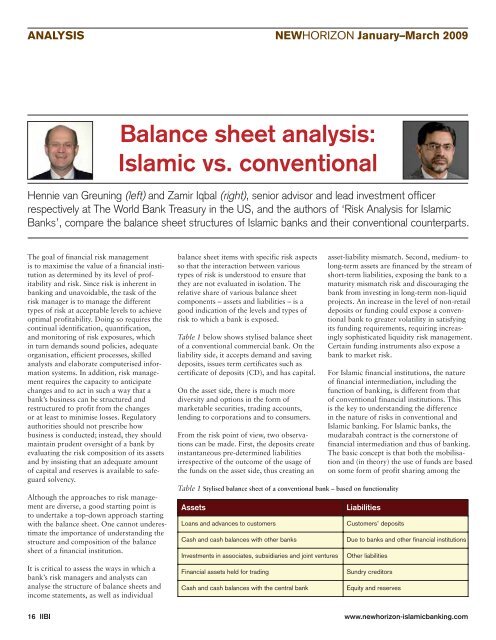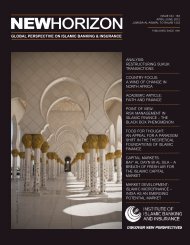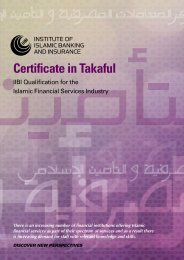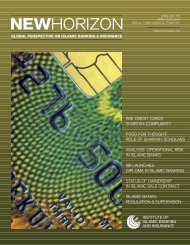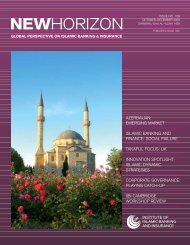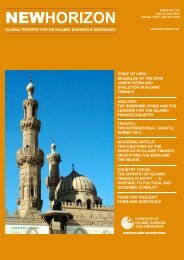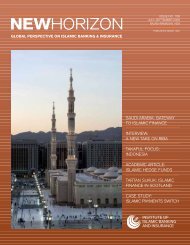the global financial crisis: can islamic finance help? - Institute of ...
the global financial crisis: can islamic finance help? - Institute of ...
the global financial crisis: can islamic finance help? - Institute of ...
- No tags were found...
You also want an ePaper? Increase the reach of your titles
YUMPU automatically turns print PDFs into web optimized ePapers that Google loves.
ANALYSIS<br />
NEWHORIZON January–March 2009<br />
Balance sheet analysis:<br />
Islamic vs. conventional<br />
Hennie van Greuning (left) and Zamir Iqbal (right), senior advisor and lead investment <strong>of</strong>ficer<br />
respectively at The World Bank Treasury in <strong>the</strong> US, and <strong>the</strong> authors <strong>of</strong> ‘Risk Analysis for Islamic<br />
Banks’, compare <strong>the</strong> balance sheet structures <strong>of</strong> Islamic banks and <strong>the</strong>ir conventional counterparts.<br />
The goal <strong>of</strong> <strong>financial</strong> risk management<br />
is to maximise <strong>the</strong> value <strong>of</strong> a <strong>financial</strong> institution<br />
as determined by its level <strong>of</strong> pr<strong>of</strong>itability<br />
and risk. Since risk is inherent in<br />
banking and unavoidable, <strong>the</strong> task <strong>of</strong> <strong>the</strong><br />
risk manager is to manage <strong>the</strong> different<br />
types <strong>of</strong> risk at acceptable levels to achieve<br />
optimal pr<strong>of</strong>itability. Doing so requires <strong>the</strong><br />
continual identification, quantification,<br />
and monitoring <strong>of</strong> risk exposures, which<br />
in turn demands sound policies, adequate<br />
organisation, efficient processes, skilled<br />
analysts and elaborate computerised information<br />
systems. In addition, risk management<br />
requires <strong>the</strong> capacity to anticipate<br />
changes and to act in such a way that a<br />
bank’s business <strong>can</strong> be structured and<br />
restructured to pr<strong>of</strong>it from <strong>the</strong> changes<br />
or at least to minimise losses. Regulatory<br />
authorities should not prescribe how<br />
business is conducted; instead, <strong>the</strong>y should<br />
maintain prudent oversight <strong>of</strong> a bank by<br />
evaluating <strong>the</strong> risk composition <strong>of</strong> its assets<br />
and by insisting that an adequate amount<br />
<strong>of</strong> capital and reserves is available to safeguard<br />
solvency.<br />
Although <strong>the</strong> approaches to risk management<br />
are diverse, a good starting point is<br />
to undertake a top-down approach starting<br />
with <strong>the</strong> balance sheet. One <strong>can</strong>not underestimate<br />
<strong>the</strong> importance <strong>of</strong> understanding <strong>the</strong><br />
structure and composition <strong>of</strong> <strong>the</strong> balance<br />
sheet <strong>of</strong> a <strong>financial</strong> institution.<br />
It is critical to assess <strong>the</strong> ways in which a<br />
bank’s risk managers and analysts <strong>can</strong><br />
analyse <strong>the</strong> structure <strong>of</strong> balance sheets and<br />
income statements, as well as individual<br />
balance sheet items with specific risk aspects<br />
so that <strong>the</strong> interaction between various<br />
types <strong>of</strong> risk is understood to ensure that<br />
<strong>the</strong>y are not evaluated in isolation. The<br />
relative share <strong>of</strong> various balance sheet<br />
components – assets and liabilities – is a<br />
good indication <strong>of</strong> <strong>the</strong> levels and types <strong>of</strong><br />
risk to which a bank is exposed.<br />
Table 1 below shows stylised balance sheet<br />
<strong>of</strong> a conventional commercial bank. On <strong>the</strong><br />
liability side, it accepts demand and saving<br />
deposits, issues term certificates such as<br />
certificate <strong>of</strong> deposits (CD), and has capital.<br />
On <strong>the</strong> asset side, <strong>the</strong>re is much more<br />
diversity and options in <strong>the</strong> form <strong>of</strong><br />
marketable securities, trading accounts,<br />
lending to corporations and to consumers.<br />
From <strong>the</strong> risk point <strong>of</strong> view, two observations<br />
<strong>can</strong> be made. First, <strong>the</strong> deposits create<br />
instantaneous pre-determined liabilities<br />
irrespective <strong>of</strong> <strong>the</strong> outcome <strong>of</strong> <strong>the</strong> usage <strong>of</strong><br />
<strong>the</strong> funds on <strong>the</strong> asset side, thus creating an<br />
asset-liability mismatch. Second, medium- to<br />
long-term assets are <strong>finance</strong>d by <strong>the</strong> stream <strong>of</strong><br />
short-term liabilities, exposing <strong>the</strong> bank to a<br />
maturity mismatch risk and discouraging <strong>the</strong><br />
bank from investing in long-term non-liquid<br />
projects. An increase in <strong>the</strong> level <strong>of</strong> non-retail<br />
deposits or funding could expose a conventional<br />
bank to greater volatility in satisfying<br />
its funding requirements, requiring increasingly<br />
sophisticated liquidity risk management.<br />
Certain funding instruments also expose a<br />
bank to market risk.<br />
Table 1 Stylised balance sheet <strong>of</strong> a conventional bank – based on functionality<br />
Assets<br />
Loans and advances to customers<br />
Cash and cash balances with o<strong>the</strong>r banks<br />
Investments in associates, subsidiaries and joint ventures<br />
Financial assets held for trading<br />
Cash and cash balances with <strong>the</strong> central bank<br />
For Islamic <strong>financial</strong> institutions, <strong>the</strong> nature<br />
<strong>of</strong> <strong>financial</strong> intermediation, including <strong>the</strong><br />
function <strong>of</strong> banking, is different from that<br />
<strong>of</strong> conventional <strong>financial</strong> institutions. This<br />
is <strong>the</strong> key to understanding <strong>the</strong> difference<br />
in <strong>the</strong> nature <strong>of</strong> risks in conventional and<br />
Islamic banking. For Islamic banks, <strong>the</strong><br />
mudarabah contract is <strong>the</strong> cornerstone <strong>of</strong><br />
<strong>financial</strong> intermediation and thus <strong>of</strong> banking.<br />
The basic concept is that both <strong>the</strong> mobilisation<br />
and (in <strong>the</strong>ory) <strong>the</strong> use <strong>of</strong> funds are based<br />
on some form <strong>of</strong> pr<strong>of</strong>it sharing among <strong>the</strong><br />
Liabilities<br />
Customers’ deposits<br />
Due to banks and o<strong>the</strong>r <strong>financial</strong> institutions<br />
O<strong>the</strong>r liabilities<br />
Sundry creditors<br />
Equity and reserves<br />
16 IIBI www.newhorizon-<strong>islamic</strong>banking.com


